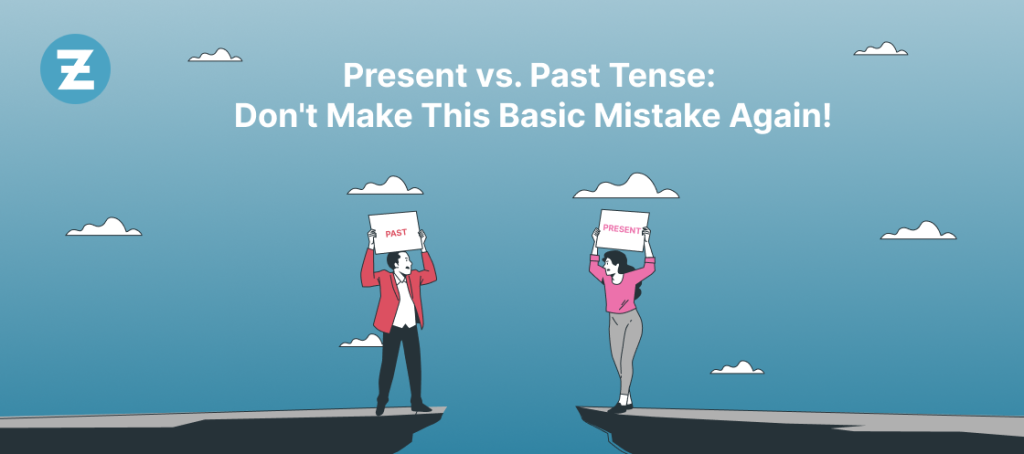English grammar can be a bit difficult, and one of the most common errors that learners make is to confuse present tense with past tense. Incorrect use of tenses may not only render your writing or speaking awkward and clumsy, but it also results in misunderstandings.
Fortunately, honing your English tense skills is simpler than you thought. By mastering the correct use of the present and past tenses, you can express yourself with precision and conviction.
Understanding the Present Tense
Do you have problems with using the present tense in your writing and speaking? Mastery of the present tense is an essential step towards improving English. The present tense describes three types of action: actions currently happening, habitual actions, and general truths.
In present-tense conjugations of verbs, remove the infinitive ending and add the appropriate suffix for the subject. For example, “I eat breakfast every morning.” In this phrase, “eat” is a verb in the present tense for the subject “I.”.
Did you know that we can create negative sentences in the simple present by adding the word “not” after the auxiliary verb ‘do’? For instance, I do not eat meat.
Accurate use of the simple present can have a great impact on your English writing as well as your speaking skills. Spotting and using simple present in everyday talk can boost your language proficiency.
Read also: 11 Types of Jokes in English
Mastering Past Tense
Using past tenses correctly is the key to effective communication in English. It implies actions or events that happened earlier, and it is very important to use the right verb forms in order to avoid errors and misunderstandings.
The first step in learning past tense is to understand the simple past tense, where an action took place at a particular time in the past. Regular verbs add -ed at the end to form this tense, while irregular verbs change their form.
Example: She laughed at his joke yesterday.
Nevertheless, there are exceptions and irregularities in the simple past tense. Thus, it is very important to memorize the common irregular verbs for clarity purposes.
| Verbs | Simple Past Tense |
| be | was/were |
| have | had |
| go | went |
| do | did |
| see | saw |
Another important aspect of past tense is understanding the past continuous tense, which is used to refer to actions that were in progress at a specific time in the past. It is formed by using the past tense of “to be” with the present participle of the main verb (-ing).
Example: They were playing soccer at 5 p.m. yesterday.
Finally, the past perfect tense is used to refer to actions that happened before another action or event in the past. It is formed with “had” + the past participle of the main verb.
Example: He had finished his homework before he watched TV.
By understanding and practicing various forms of past tense, you can accurately express actions or events that occurred in the past, thereby improving your English language proficiency and communication skills.
Common Errors in Tense Usage
English improvement occurs when you grasp the correct use of tense, but some of the mistakes that are usually made are in tense. Your English grammar will improve at a very fast pace if you concentrate on the basics and do some easy things. Here are some frequent tense mistakes to watch out for:
1. Confused between Present Perfect and Past Simple
Despite the fact that present perfect and past simple tenses may appear alike, they are different in meaning. One of the mistakes is using the present perfect for something that happened in the past. For instance, say “I have eaten breakfast” instead of “I ate breakfast.”.
2. Misuse of Past Simple and Past Continuous
Be careful about using past simple vs. past continuous tense. In general, the past continuous is used for an action in progress, and the past simple is used for an action that’s already finished. Say, for example, “I was walking” instead of “I walked.”.
3. Mistakes with Auxiliary Verbs
A frequent blunder is the wrong auxiliary verb, often because native speakers tend to contract them in spoken English. Simply ensure that you are using the right one, such as do, did, is, or was, etc., like “I didn’t know” instead of “I didn’t know.”.
4. Unnecessary Tenses
Also, the use of unnecessary tenses can cause mistakes. Be careful with the future perfect simple tense in particular. Most times, it is not necessary and can be replaced by other tenses like present perfect or future simple.
You can improve your tense consistency and communicate more effectively in English by eliminating these mistakes.
Selecting the appropriate tense for English communication is crucial to clear and accurate language. Below are some tips that will help you find your way to the right tense:
1. Time Frame Consideration
Maybe you should think about when the action occurred or will occur in order to choose the right tense. For finished actions, use past tense; for ongoing actions, use present tense; and for actions yet to occur, employ future tense.
2. Watch out for signal words
Signal words such as yesterday, today, and tomorrow can tell us what kind of tense we should use. Yesterday is used with the past, today is used with the present, and tomorrow is used with the future.
3. What are you trying to achieve?
Another consideration regarding which tense to use may come from the purpose of your message itself. Use present tense for general truths and past tense for specific events already completed, while the future is helpful with plans and predictions.
4. Consistency
In terms of the usage of tenses, consistency is very important. Unless there is a good reason to change tenses, be consistent within sentences, paragraphs, or pieces of writing. Your reader may become confused by any inconsistencies in your work and misinterpret it altogether.
These tips are expected to assist you in enhancing your choice of tenses so that your meaning remains obvious in all possible contexts, as well as improve your proficiency in using them; however, it requires practice and time to master this particular aspect completely.
| Enhance your language skills with ZoundsLike, ensuring smooth and confident interactions |
A Few Points to Note About Tenses in Writing
Good writing does not only need good grammar but also proper use of tenses. If you don’t keep your tenses consistent, it is easy for readers to become confused and miss out on your message. To ensure tense consistency and improve writing skills, try these methods.
1. Maintain consistency from a point of view
Determine the exact point of view that you are going to use in your essay and keep it throughout. This will help you avoid useless shifts in tenses that can distract a reader. For example, if you decide to write in the present tense, make sure that all other verb forms are also in the present tense without suddenly shifting into the past tense.
2. Use transition words to show changes in time references
There are transition words that indicate that a shift has occurred as far as tense is concerned. The terms “yesterday,” “last year,” and “earlier today,” for instance, indicate that there is a change towards the past tense (Feist, 2006). Similarly, terms like tomorrow, later, and next week suggest a shift to the future (Feist 2006). You should use such words carefully so that the change of state is clear and purposeful.
3. Completed action: simple past
To describe actions that occurred in the past and have since been completed, use simple past tense. For example, I walked to the store yesterday. This clearly indicates the completion of an action done at a certain time previously.
4. Use the present perfect continuous for actions performed in the past and still continuing up to now
Use present perfect continuous to talk about actions that started in the past and are still continuing up to now, e.g., “I have been studying English for three years.” The use of this tense emphasizes the beginning of an action in the past that is still happening.
5. Use Past Perfect for Actions Completed Before Another Past Action
To describe an action that took place before another one in the past, make use of the past perfect tense; for example, “I had already eaten breakfast before he arrived.” Here, the tense shows that eating breakfast was done in the past before the arrival happened.
By doing this, you will have consistency in your tenses and ensure your readers get your message clearly. This will enable you to improve English grammar and also enhance your writing skills through practice.
Speaking fluently
Accuracy and self-assurance are necessary in speech for effective communication. The section is aimed at providing practical strategies and exercises for improving your speaking skills, with a specific emphasis on using the correct tenses in everyday conversations.
1. Practice, practice, practice
Practicing English conversation on a regular basis is the secret to becoming more comfortable and confident. Seek out opportunities to speak with native speakers, join conversation groups, or hire a tutor. The more you practice, the easier it will be to handle tense correctly in any situation.
2. Listen to native speakers
Improving your English-speaking skills can be achieved by listening to native speakers. Listen to how they pronounce, their intonation, and their manner of speaking. Native speakers have different uses of tenses for different situations; thus, listen carefully and imitate what they say.
3. Use visual aids
Visual aids like diagrams can be helpful in grasping the essence of how various tenses work in English as well as the correct occasions when they should be used. Make flashcards or visuals that depict different tenses and their corresponding verb forms.
4. Engage in role-play
Acting out is a fun and interesting way to learn how to speak English and become fluent. For example, you can choose a scenario like buying food at a restaurant or engaging in a conversation with a stranger and try as much as possible to use the right tenses.
5. Seek feedback
To enhance English-speaking skills, one should not take it lightly when it comes to feedback from either tutors or native speakers. You may ask them if your tenses, pronunciation, or grammar are wrong. Make sure that you notice wherever you are going wrong and work on it consistently.
Through these strategies and exercises, you will be able to improve your spoken English skills with better accuracy in the use of tenses, hence being more confident while conversing with others on a daily basis.
Read also: English Phrases for Asking a Favor
Consistency with Time in a Narrative
It is necessary to write using the correct tenses in order to have a consistent story line as well as make it easy for the reader to understand. A narrative that employs the right tense all through is smooth-flowing, hence allowing the reader to grasp everything fully.
One of the ways that one can maintain consistency of tense is by establishing the context of the story, or when it occurred. The time when events take place determines which tense should be employed. If something is happening now, then present tense would be suitable; however, past tense would be used for historical events.
Further, another vital principle for maintaining tense consistency requires using one verb tense throughout the narration. Jumping between past and present tenses can confuse readers and affect the coherence of your story negatively. To show that there are changes in time, therefore, requires very swift transitions, and this can only be made possible through transitional words like “after,” “when,” and “before.”.
Remember that not all narratives require the same type of tense consistency. Your choice of tense depends on how you want your story told and how well you expect your audience to be part of your work. Therefore, writing skills have to be sharpened through continuous practice and improvement in our control over tenses going forward. Continue practicing as well as experimenting until you feel comfortable with how much tension you inject into your paragraphs.
However, note that while maintaining tense consistency is important in storytelling, do not let it interfere with your storytelling technique too much; after all, we must consider character development, plot advancement, and setting establishment over consistent tenses used within our narratives.
Conclusion
To improve English, understanding the usage of present and past tenses is crucial. This knowledge prevents common mistakes, ensuring coherence and accuracy in your English writing and speaking.
Consistent use of tenses is essential in various situations, so deepen your grasp of grammar complexity. Regular practice, coupled with careful attention to your work, can make you comfortable communicating in English with both native and non-native speakers.
For a comprehensive language learning experience, explore ZoundsLike. Download the app now and embark on your language learning journey!
FAQs
Q1.What is the present tense, and when should it be used?
The present tense is used to describe actions happening now or actions that are always true. It is also used for future actions that are part of a schedule or plan.
Q2.How do I conjugate verbs in the present tense?
To conjugate verbs in the present tense, you need to change the form of the verb according to the subject. For regular verbs, add -s or -es to the base form for third-person singular subjects.
Q3.What is the past tense, and when should it be used?
The past tense is used to describe actions or events that have already happened. It is used to talk about past experiences, finished actions, or past habits.
Q4.How can I choose the right tense for different contexts?
To choose the right tense, consider the time of the action, its duration, whether it is a repeated action, and the relationship between the actions. Also, pay attention to signal words that indicate specific tenses.
Q5.How can I improve my spoken English skills and use the correct tenses confidently?
Practicing speaking English regularly with native speakers or language partners can help improve your spoken English skills. It is also beneficial to listen to and imitate native speakers to develop a natural sense of tense usage.








